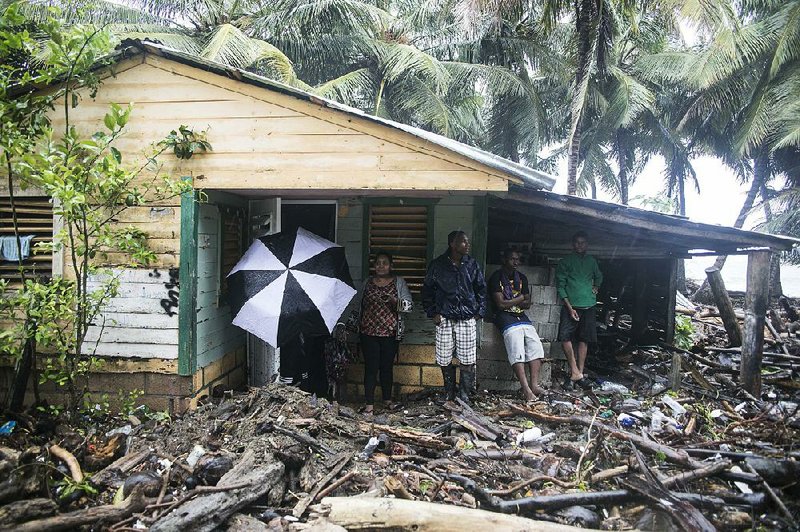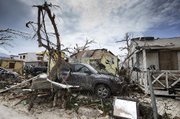MIAMI -- Caribbean islands pummeled by Hurricane Irma began to grapple with the storm's toll Thursday as residents of south Florida packed highways heading north, seeking safer ground as Category 5 Irma churned closer.
The National Hurricane Center in Miami issued a hurricane warning Thursday for the southernmost part of Florida, the first such alert Irma has prompted in the United States. A storm-surge watch, warning of the potential for life-threatening levels of water, also was issued for the southern part of the state, which includes the Florida Keys. Mandatory evacuations of the Keys began Wednesday.
Irma pinwheeled through the Caribbean, leaving in its wake leveled neighborhoods, ravaged seafronts and at least 11 dead, according to government officials and news reports.
The storm was set to track toward the Bahamas with sustained winds of 175 mph late Thursday and gusts even stronger, according to the hurricane center, which warned of storm surges capable of swallowing vast sections of the coast. The hurricane was centered about 55 miles west-southwest of Grand Turk Island and was moving west-northwest at 16 mph.
Click here for larger versions
Photos by The Associated Press
Photos by The Associated Press
After the Bahamas, Irma's expected path takes it to Florida, including the ribbon of cities, dense suburbs and swampland that are home to more than 6 million people from Palm Beach to Miami-Dade counties.
Florida Gov. Rick Scott urged extreme caution in the face of a powerful storm that could quickly change course.
"Every Florida family must prepare to evacuate regardless of the coast you live on," he said.
Scott said evacuations in the state may stretch "coast to coast" from the Atlantic to the Gulf of Mexico. With potentially millions of people hitting the highways to escape, Scott said emergency efforts were underway to keep fuel shipments moving to gas stations.
[HURRICANE TRACKER: Follow Irma’s projected path]
Late Thursday, Scott ordered all of the state's schools, colleges and universities, as well as state offices, closed from today through Monday.
Earlier, Miami-Dade County, the state's most populous with more than a half-million people, began evacuations along the coast.
"Take it seriously, because this is the real deal," said Maj. Jeremy DeHart, a U.S. Air Force Reserve weather officer who flew through the eye of Irma at 10,000 feet.
In Naples, Fla., a Best Buy store opened Thursday morning to about two-dozen shoppers waiting outside. Mike Ducheneau, the manager, said the store had gotten 20 or 30 cellphone chargers delivered the previous night. The shoppers waiting in line flooded to the cellphone section, snatching up the chargers that remained.
"They're [nearly] always in stock," Ducheneau said. "This was an anomaly."
HAITI PREPARES
By Thursday morning, as Irma's eye moved north of the island of Hispaniola, aid workers in Haiti -- a nation already devastated by a major earthquake in 2010 and Hurricane Matthew in 2016 -- were preparing for yet another potential disaster.
The hurricane was still north of Haiti and the Dominican Republic by Thursday evening, sweeping the island's two nations with high winds and rain while battering the Turks and Caicos islands on its other side.
Haiti, on the western side of Hispaniola island, raised its hurricane alert level to red, its highest, and the north coast remained under a hurricane watch as the central coast faced the threat of tropical storm winds and rain.
Big waves smashed a dozen homes into rubble in the Dominican Republic fishing community of Nagua, but work crews said all the residents had left before the storm. Officials said 11,200 people in all had fled from vulnerable areas, and 55,000 soldiers had been deployed to help with the cleanup.
Aid groups in Haiti said the national hurricane response appeared to be slow. Many evacuations in the north were set to unfold as rains rapidly approached and low-quality shelters were still being finished.
School was canceled across the country as national warnings went out through social media, radio and television. In some remote towns, word to take shelter was being spread largely through local officials with bullhorns.
Two people were injured by a falling tree, a national roadway was blocked by debris and roofs were torn from houses along the northern coast, but there were no immediate reports of deaths.
Officials warned that could change as Irma continued to lash Haiti, where deforested hillsides are prone to mudslides that have wiped out entire neighborhoods of rickety homes in flood zones.
Another key concern was the spread of cholera that's already plaguing Haiti. International aid groups already have a large presence in the nation because of the series of natural disasters there, and many of the groups said they were ready with teams and vehicles to help distribute medical and food aid.
About 1 million people were without power in Puerto Rico after Irma sideswiped the island overnight, and nearly half the territory's hospitals were relying on generators. No injuries were reported.
Irma has left behind a string of once-lush islands scoured clean by the storm's force. Aerial images released by the Dutch Defense Ministry on the island of St. Martin, which is split between Dutch and French control, showed homes with roofs sheared away and palm trees stripped bare.
French Prime Minister Edouard Philippe said four people were confirmed dead and about 50 were injured on the French side of St. Martin.
At least four people were killed in the U.S. Virgin Islands, and officials said they expected to find more bodies. Authorities described the damage as catastrophic, and said crews were struggling to reopen roads and restore power.
Three more deaths were reported on the British island of Anguilla, independent Barbuda and the Dutch side of St. Martin.
Irma also slammed the French island of St. Barts, tearing off roofs and knocking out electricity.
French Interior Minister Gerard Collomb said 100,000 food rations were sent to St. Barts and St. Martin, the equivalent of four days of supplies.
On St. Martin, there was little sense that authorities had the situation under control. Witnesses said supermarkets were being looted, with no police visible in the streets.
"It's like someone with a lawn mower from the sky has gone over the island," Marilou Rohan, a European vacationer on the Dutch side of the island, told the Dutch NOS news service.
Rohan said she sometimes saw soldiers pass by, but they were doing little to impose order.
In the U.S. Virgin Islands, Gov. Kenneth Mapp said the U.S. military was sending troops to aid relief efforts. The primary focus for now is "making sure people have meals, water and shelter," Mapp said.
Britain was sending hundreds of troops and the navy flagship HMS Ocean to Anguilla, Montserrat and the British Virgin Islands.
In Anguilla, officials reported extensive damage to the airport, hospitals, shelters and schools, and said 90 percent of roads were impassable.
On Barbuda, about 95 percent of the island was damaged when the hurricane's core crossed over the island early Wednesday, Antigua and Barbuda Prime Minister Gaston Browne said, and about 60 percent of its roughly 1,400 residents were left homeless.
When Craig Ryan, a 29-year-old tourism entrepreneur who lives in Antigua, reached Barbuda by boat Thursday morning, the scene of residents flocking onto the beach seeking help struck him as a "Caribbean version of Dunkirk," the World War II evacuation of Allied troops from a French coastal city.
"It's such a level of devastation that you can't even see structures standing," he said in a telephone interview.
The death toll fluctuated Thursday as officials released, then revised, the number of fatalities. And with many places in the Caribbean taking direct hits from Irma, the toll was expected to rise when officials are able to communicate with people on the devastated islands.
The U.S. consulate general in Curacao said about 6,000 Americans were believed to be stranded on St. Martin.
The consulate said it is collecting the names and locations of the stranded and is working with the U.S. and other governments to figure out how to get the Americans off the island.
Earlier in the day, Irma's sustained winds of 185 mph were the strongest recorded for an Atlantic hurricane making landfall, tied with the 1935 Florida Keys hurricane. The Florida Keys are particularly vulnerable to Irma, and Monroe County, home of the Keys, began mandatory evacuations of tourists and residents alike Wednesday.
WATCHING DAY TO DAY
While forecasts have warned that south Florida could take a direct hit, what is unclear is precisely where the center of the storm and the destructive winds of the eye wall will make landfall, experts said.
"The wild card here is the turn," Mark DeMaria, acting deputy director of the National Hurricane Center, said as his colleagues stared at screens showing the approaching Category 5 storm. "Anytime a hurricane makes a turn, it introduces uncertainty."
He said the models have been consistent, and day-to-day changes haven't been dramatic.
Florida's geography, its population density pattern and Irma's projected track are particular concerns with this storm, experts said.
Just last month, Florida marked the 25th anniversary of Hurricane Andrew, which made landfall as a Category 5 storm and tore through a stretch of what is now known as Miami-Dade County. That storm, along with Hurricane Harvey's recent devastation in Texas, has lingered in the minds of Floridians in recent days.
"This storm is bigger, faster and stronger than Hurricane Andrew," Scott said Wednesday, emphasizing that even with Irma's uncertain trajectory, officials were preparing for a direct impact.
Scott has declared a statewide emergency and warned that in addition to potentially forcing large-scale evacuations, Irma could batter areas that last year were flooded by Hurricane Matthew. A state of emergency was also declared Wednesday in North Carolina and South Carolina.
By the time Rosi Edreira and her husband got the order to leave their home in Cutler Bay, part of the evacuation zone in Miami-Dade County, they had already made plans to seek shelter in Charlotte, N.C. Into the car went photo albums; birth certificates; nearly 400 Christmas ornaments collected over a quarter-century; their two dogs, JJ and Coco Puff; and cat, Dicky.
"I did Andrew," said Edreira, 49, recalling the Category 5 hurricane that ripped off the roof of her home 25 years ago. "I'm not doing that again."
Meanwhile, in the Gulf of Mexico, Hurricane Katia has prompted warnings in Mexico's Veracruz state. That storm had top winds of 80 mph late Thursday.
Farther out in the Atlantic, Hurricane Jose strengthened to a Category 3 storm with 120 mph winds and posed a potential threat for Saturday to some of the same islands ravaged by Irma.
"We are very worried about Hurricane Jose," Browne said Thursday.
Information for this article was contributed by Joel Achenbach, Mark Berman, Anthony Faiola, Lindsay de Feliz, Daniel Cassaday, Francisco Alvarado, Patricia Sullivan, Angela Fritz, Jason Samenow, Sandhya Somashekhar, Brian Murphy and Steven Mufson of The Washington Post; by Evens Sanon, Danica Coto, Ezequiel Lopez Abiu, Anika Kentish, Seth Borenstein, Michael Weissenstein, Samuel Petrequin, Ben Fox, Terry Spencer and Meghan Hoyer of The Associated Press; and by Frances Robles of The New York Times.
RELATED ARTICLES
http://www.arkansas…">FEMA keeping one eye on Texas, one on Floridahttp://www.arkansas…">$15B in disaster aid clears Senate
A Section on 09/08/2017


